A world-class city doesn’t attract millions of residents and global notoriety by accident. Toronto, the most populous city in Canada and fourth-largest in North America, has earned its place as one of the world’s ten-most liveable cities by fostering a safe and stable environment, with relatively easy access to education and healthcare — not to mention some of the best restaurants in the nation. Notoriety like this comes with a caveat, however: be prepared to pay a lot to live there.
So where can one find a bargain when condo-shopping in downtown Toronto? Roomvu, a real estate marketing and analytics company, analyzed condo rent prices through the first seven months of 2020 to find out. They also compared this year’s average rental prices and compared them with 2019 numbers to see to what extent the Covid-19 pandemic has impacted prices.
There were more than 21,280 condos rented in the Greater Toronto Area in which more than 8,730 of them were rented in Downtown Toronto from January 1st to July 31st this year. While regional delimitations make it easy to compare variance in rental prices between, say, Scarborough and Etobicoke, examining which neighbourhoods are the most expensive within Downtown Toronto requires a deeper dive.
Luckily, the postal code makes it relatively easy to parse through the data. Below is a list of postal codes and the neighbourhoods contained within them.

Given the differences in amenities and proximity to the action that exist within these areas, it stands to reason that prices would fluctuate from postal code to postal code. Roomvu plotted the average rental price of condos by postal code using sales data on the more than eight thousand condos sold in 2020. Below are the results.
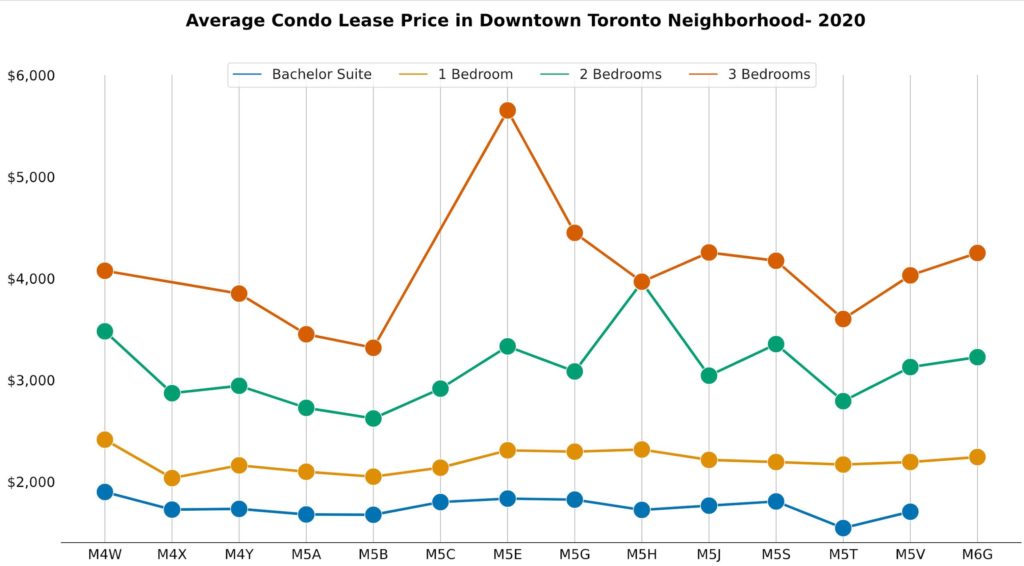
With respect to two-bedroom condos, the M5H postal code is normally a tough one in which to find a bargain. The attractiveness of this area is due in large part to buildings associated with iconic global brands like Google, the Sheraton Centre Hotel, and the Hilton, world-class restaurants like Momofuku and Soho House Toronto, and proximity to City Hall. However, when Roomvu took a deeper look into 2020 data and compared with last year, found interesting facts about this area that will be covered later on in this article.
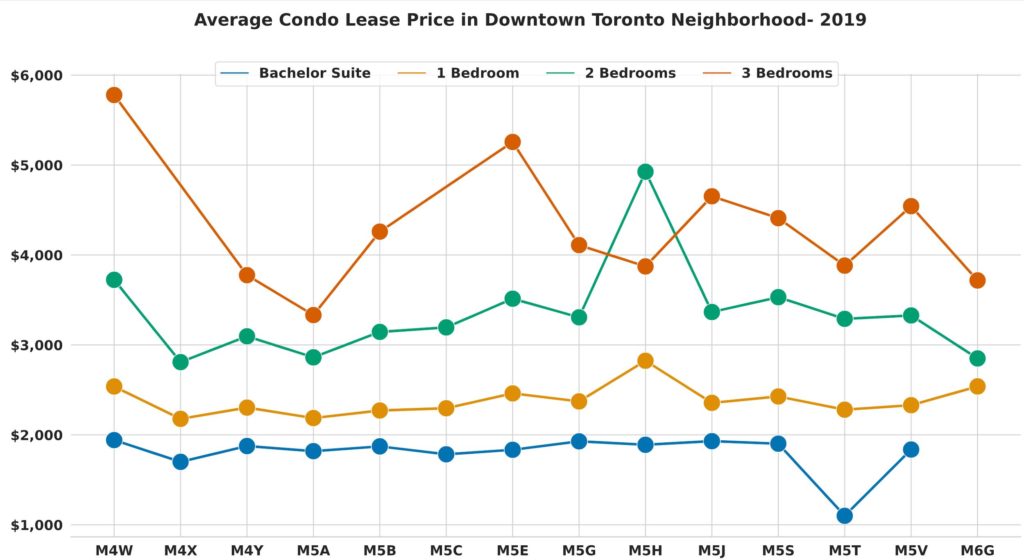
Not only is it hard to find a bargain in this area, it is the most expensive postal code overall in Downtown Toronto. The average rent for a two-bedroom apartment was almost $3,963 per month, and $2,316 for a one-bedroom apartment so far in 2020. These numbers actually represent a decrease from 2019, when average rents for two- and one-bedroom apartments were $4,926 and $2,824, respectively. Figure 3 illustrates the average rent price of different condos in the last year.
When affordability is the name of the game, the bachelor suite, perhaps unsurprisingly, is the way to go. On average, the price of a bachelor suite across Downtown Toronto was between $1,540 and $1,900 during the first half of 2020. However, when compared to 2019, rents were higher, ranging from $1,100 to $1,940. The cheapest one-bedroom apartments can be found in the eastern part of Downtown in St. James Town, Cabbagetown and Ryerson, which make up the M4X and M5B postal codes.
Figure 4 paints a picture of how much average prices have dropped this year compared to 2019, and how much individuals can expect to pay for different types of condos. The overall average rental price for a three-bedroom condo is a healthy $4,038 per month in 2020, with two- and one-bedroom condos costing about one-thousand dollars less.
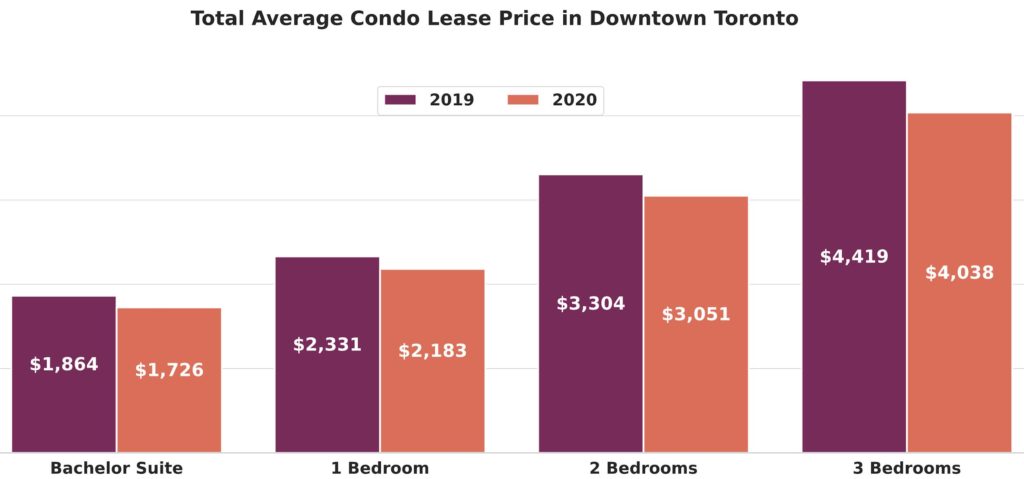
Both in the first seven months of 2019 and 2020, the most popular rented properties were one-bedroom condos numbering 5,573 and 5,368 properties, respectively. According to data collected and analyzed by Roomvu, three-bedroom condos are the least popular ones among rental properties.
Figures 5, 7, 9, and 11 compare the average price of different apartments in 2020 with 2019 across different postal codes (where sales data was available). Heretofore, in almost all Downtown Toronto neighbourhoods, rents have declined — the economic and social impacts of the novel coronavirus being a potential cause for this decrease.
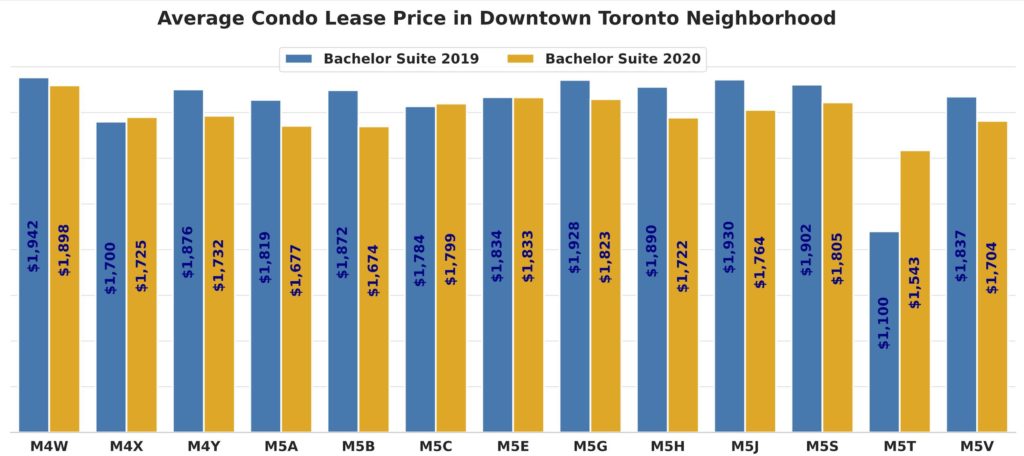
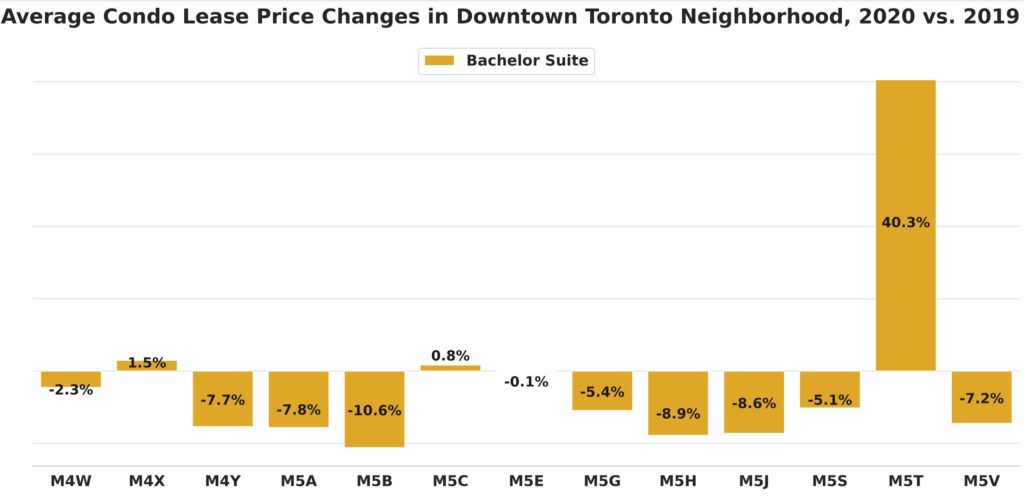
To illustrate the changes in rent prices, Roomvu examined these year-to-year changes and presented them as a percentage. As shown in Figure 6, the Ryerson and Garden District neighbourhoods have experienced the biggest price drop with respect to bachelor suites so far. Although, the most affordable bachelor suites won’t be found in Ryerson and the Garden District. Although rents rose significantly in Kensington Market, Chinatown and Grange Park (M5T), cost-conscious apartment shoppers will need to check out this neighborhood for the best deals on bachelor suites.
As depicted in Figure 7, rent prices for one-bedroom condos decreased in all Downtown neighbourhoods. Figure 8 further exemplifies this trend, in the M5H postal code above all, where it would appear the pandemic has rendered one-bedroom apartments more affordable in this area by 18 per cent price drop for a one-bedroom apartment.
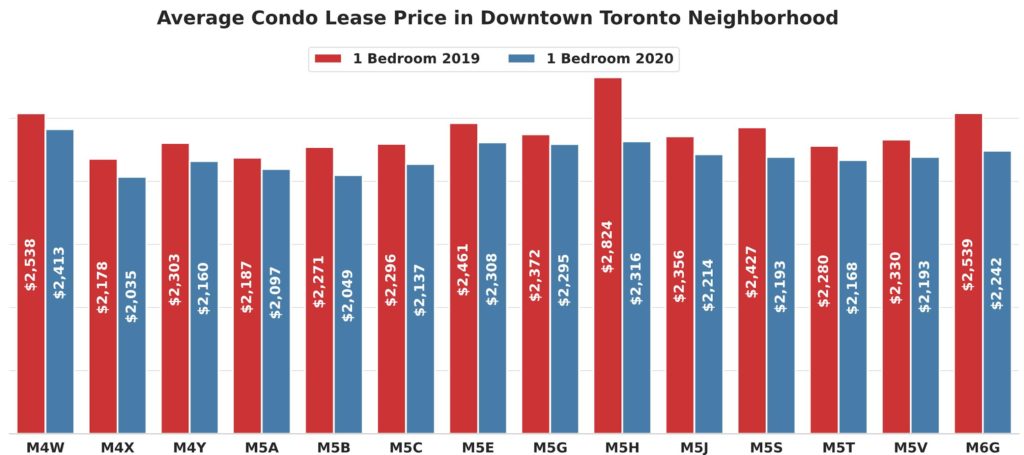
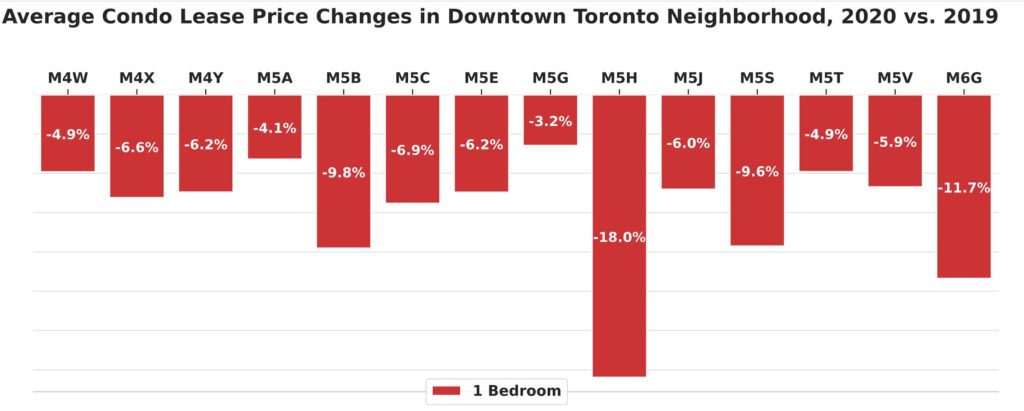
As illustrated in Figure 9, prices for two-bedroom condos in the infamous M5H postal code have remained relatively high in 2020 much like they were in 2019. Despite the notable pandemic-related year-to-year drop in prices especially on Adelaide Street West, King Street West, Queen Street West, and Richmond Street West (19.5% decrease), the most expensive two-bedroom condos in the city are still located in this neighborhood (M5H). The next highest year-to-year drop in prices occurred in Ryerson and the Garden District areas (M5B, Figure 10). It’s also where one can find the most affordable two-bedroom condos this year.
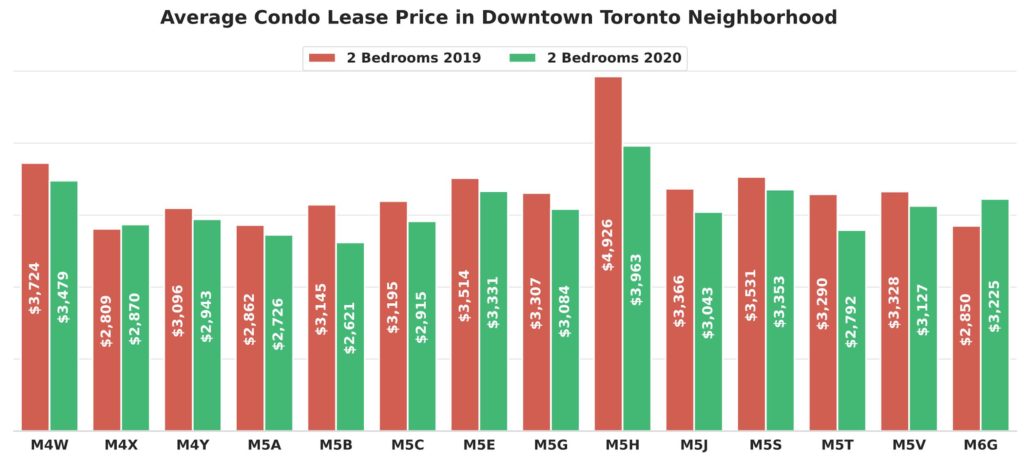
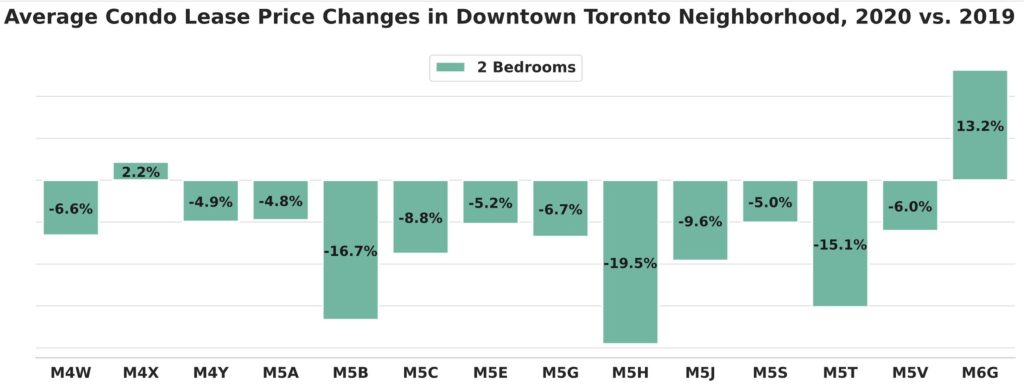
Prices have declined with respect to three-bedroom condos as well, where the decline has been observed across nearly all Downtown neighbourhoods in Figure 11 (where sales data was available). Figure 12 shows that the Rosedale neighbourhood (M4W), which had the most expensive bachelor suites and three-bedroom condos in 2019, experienced the most dramatic price drop for three-bedroom apartments in 2020. So far in 2020, Ryerson is where the most affordable three-bedroom apartments are located.
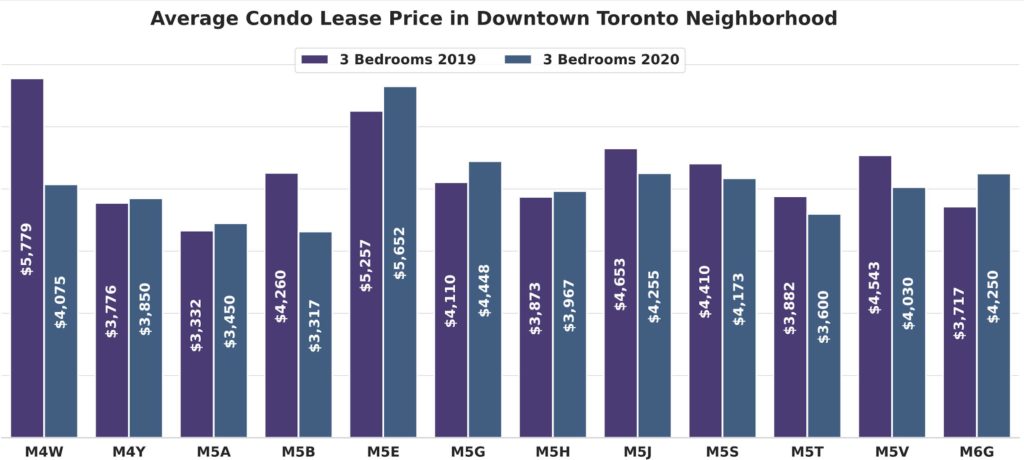
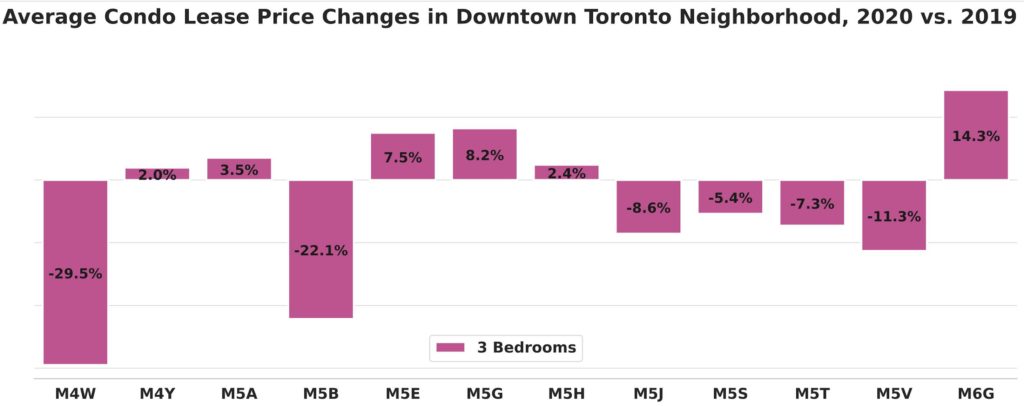
Using postal codes as a way to compare rental prices probably isn’t the first trick that comes to mind. But for students and professionals who want or need to be near Toronto’s downtown core, while finding the most affordable cost of living, relying on the familiar letter-number-letter directory can reveal where one can save a buck or two. Up to July 31st 2020, compared to the same time in 2019, the aforementioned M5H postal code, is where to look for the best bargain, especially for those in the rental market for one- and two-bedroom condos.
Unfortunately, it won’t change the fact that Toronto remains one of the least affordable housing markets in North America — and will remain so for the foreseeable future.
